Suji ka halwa recipe aka sooji halwa recipe is a traditional Indian dessert which is crazily popular in the subcontinents of south Asia. It’s rich, soft and fluffy in texture, full of flavours, irresistibly delicious and an absolute morish. Suji halwa is basically an Indian semolina pudding prepared with semolina aka Rava, ghee aka clarified butter, sugar, chopped nuts and flavoured with cardamom powder. This decadent dessert is perfect for spreading sweetness, warmth, comfort and joy throughout the year. It is mostly relished as dessert after lunch or dinner or as evening snacks. It is mostly served warm to enjoy its best taste.
Indian sweet recipes play a vital role in Indian culinary as well as Indian culture. In any part of India, festivals or ceremonies are incomplete without sweets. In fact, someone’s success or any good news is celebrated by sharing sweets with their close ones. Any celebration with homemade sweet recipes makes every occasion more special and worthier. And when it comes to homemade sweets, halwa recipes and kheer strike first in any homemaker’s mind.
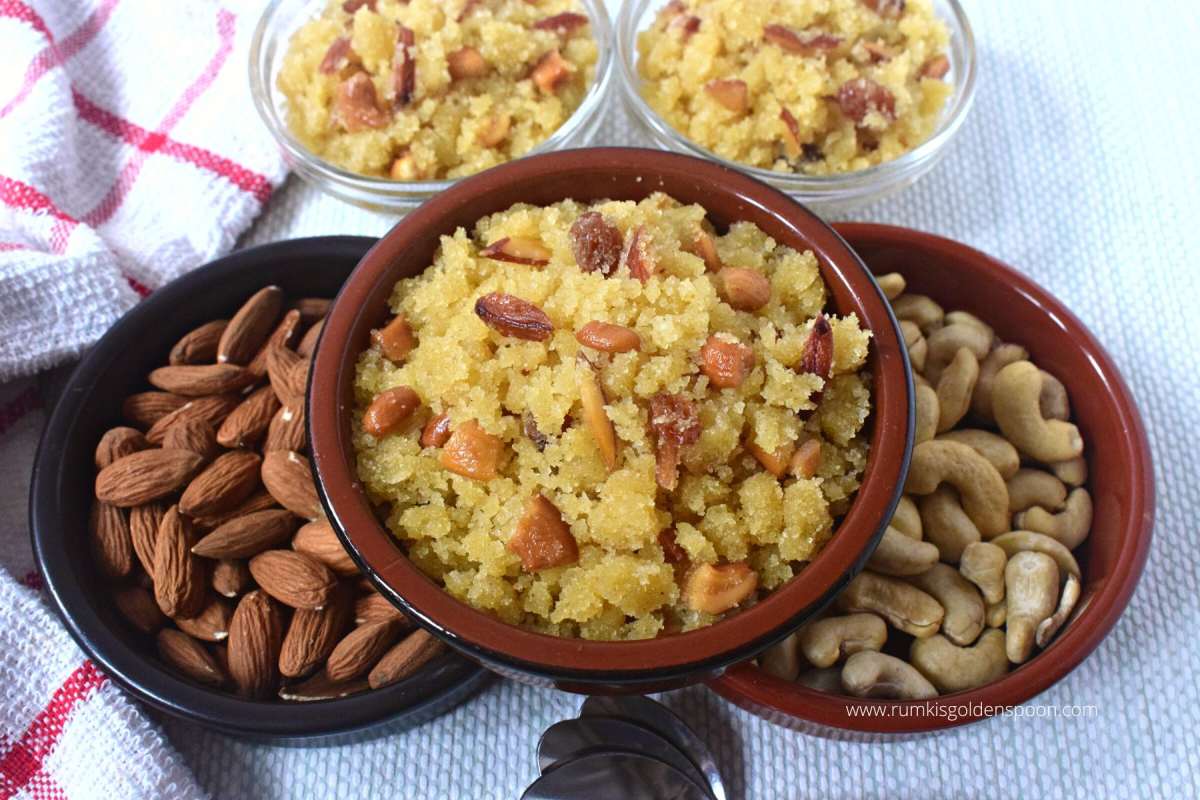
Table of Contents
About the recipe
Tips and Suggestions
Frequently Asked Questions
How to make Sooji Halwa (step wise photos)
Recipe Card
What is Suji Halwa?
Suji halwa is a classic Indian dessert and the name itself explains the dish. Here Suji or sooji stands for semolina and halwa means sweet pudding. In India, different types of halwa are prepared with different primary elements like semolina, lentils, nuts, seasonal fruits etc. But suji halwa is undoubtedly one of the most frequently prepared and beloved halwa recipes in every Indian household.
This candid dessert is prepared all over India in different ways using different techniques and different compositions of ingredients. There is no hard and fast rule to preparing the halwa recipe and in every way, it tastes luscious. It is known by different names in the different subcontinents of India. In the north, it is known as suji halwa or suji ka halwa. In the east, it is popular as mishti sooji. In south, it is known by kesari aka rava kesari or kesar bath. In Maharashtra, Karnataka and a few parts of Andhra Pradesh, it is popular as rava sheera or simply sheera.
Normally, in the suji ka halwa preparation, semolina is roasted in ghee thoroughly and then cooked in sugar syrup till soft. The addition of flavouring agents like cardamom powder, saffron and dry fruits is completely optional.
But many other variations can also be done in it. Many people make the suji halwa with milk instead of water to make it richer and creamier. That is also known as milk Kesari. There are different fruit pulps like mango, pineapple, banana etc. that can also be added to flavour up the suji halwa. You can check my mango sheera recipe.
Suji ka halwa is most frequently prepared as Prasad and offered to God during festivals like Navaratri, Ganesh Chaturthi etc.
Other than that, suji halwa is prepared with only 4 basic ingredients and gets ready in 20 minutes so it could be a great option for sudden guests.
Reasons behind the popularity of suji ka halwa
Suji ka halwa recipe is undoubtedly one of the quintessential Indian dessert recipes which are crazily popular all over India, Pakistan, Bangladesh and a few other subcontinents of south Asia. The reasons behind its unparallel popularity are
- Its irresistible taste, texture and flavour
- Its richness makes it a perfect dessert for every festival of all seasons
- Perfect to be served as evening snacks and dessert after a meal
- It can be prepared with only 4 basic ingredients
- It gets prepared very easily within 20 minutes
- It has a long shelf life and can be stored in the fridge for long
- It can be frozen for months in the freezer
- It is vegetarian
Whenever I talk about this rich, flavorful suji halwa recipe, it always makes me feel nostalgic. I have grown up eating this indulging dessert and it’s undoubtedly one of my favourites. I have thousands of good memories attached with this sweet dish.
I still remember my childhood days. During the time of Navaratri, my mom used to prepare suji ka halwa as Prasad. She used to take a big kadai and prepare a large quantity of the recipe for suji ka halwa. The whole house used to smell divine with the sweet and nutty flavour of roasted semolina, ghee and cardamom powder.
Even when my gang of school friends used to visit our house to play during holidays, my mom used to prepare this quick and easy-to-make luscious suji halwa for everyone within 20 minutes. My friends and I used to devour it with utter pleasure.
I have learned this exemplary dessert recipe from my mom. It is one of my most frequent desserts which I prepare whenever I crave something sweet.
According to our grannies, the key to preparing perfect suji halwa is the correct proportion of ingredients i.e. 1: 1: 1 of sooji: ghee: sugar and double the amount of water. It means for 1 cup sooji, 1 cup ghee and 1 cup sugar is used and the quantity of water should be 2 cups. But According to me, a little bit of cut in the amount of ghee does not impact the taste and texture of the halwa. So I have reduced the amount of ghee in this recipe and increased the amount of water to balance the texture. It does not affect the taste and texture of the halwa and at the same time, reduces the calories a little bit.
Suji ka halwa recipe aka sooji halwa recipe is a super simple and quick recipe which requires minimal ingredients to get prepared. The difficulty level of cooking this dessert recipe is low and is perfect for a novice. All the ingredients required to prepare the dish are easily available in any Indian kitchen pantry. It is a full proof recipe, and nothing can go wrong with it. The best part of the recipe is that it can be doubled or tripled in quantity by increasing the ingredients to the same proportions without investing any extra effort or time. It could be a perfect dessert option for any small party or get-together in any season.
Suji ka halwa ingredients
As I have already mentioned above, the traditional suji ka halwa is prepared with only 4 basic ingredients semolina, sugar, ghee and water. The rest of the ingredients are optional.
Semolina or Rava: The most primary ingredient of the recipe which provides body and texture to the dish.
Clarified butter or ghee: Another important ingredient for the recipe. It is used to roast the semolina to resist the Rava sheera to become sticky or soggy. It provides a soothing flavour and taste to the suji halwa and increases the shelf life. Unflavoured oil can also be used instead of ghee, but the usage of ghee makes the recipe tastier and aromatic.
Sugar: It adds sweetness to the dessert. Grated jaggery or unrefined sugar can also be used instead of regular sugar.
Water: It is used to cook the semolina or rava till soft. Milk can also be used instead of water for a richer version.
Chopped nuts: Chopped nuts are used in the suji ka halwa to provide flavor and bite. You can use a choice of nuts like cashew, pistachio, almond or walnut for the recipe.
Cardamom powder: It is used as a flavouring agent for the semolina halwa. In most Indian sweets, elaichi aka cardamom powder is used to enhance the flavour of the desserts.
How to eat suji ka halwa?
Suji ka halwa recipe is one of the most popular sweets of India and it is eaten in different ways. It tastes best when it is served warm. But it can also be served cold or at room temperature.
Semolina halwa is mostly served as evening snacks with other snack items. It can also be served as dessert after lunch or dinner.
Sooji ka halwa with poori is another splendid combination which is served in many ceremonies and popular restaurants.
Sooji ka halwa recipe with step-by-step photos and instructions have been provided in the ‘Instructions’ section of the recipe. I have included my tip and tricks below in detail to make the recipe easier for you. So that you can get the perfect result on your first attempt. But before directly jumping into the recipe, let me share a few interesting facts about the recipe.
Tips to prepare perfect suji ka halwa
- The key to getting perfect sooji ka halwa is the correct ratio of suji, sugar and ghee. So please follow the measurement mentioned in the recipe card.
- Frying the semolina in ghee is the most important part of the recipe. At this stage, you can’t be lazy. You have to stir the content continuously for even roasting.
- Always roast the semolina on medium to medium-low flame and roast it until the ghee gets separated. Don’t try to cook it on high flame to save your energy or time. It will not get cooked properly and may burn.
- Stir the content continuously during the time of preparing halwa or else it will stick to the sides and bottom or lumps may occur.
- Though it is optional but add chopped nuts of your own choice to enhance the taste and flavour of the dish.
- Don’t skip cardamom powder from the recipe. It complements the flavour of the dish.
Frequently asked Questions
What type of suji is to be used for halwa?
To be honest, there is no hard and fast rule to picking a specific variety of suji aka semolina for the recipe. If you like a smoother and soft version of halwa then you can use the fine semolina for the recipe. But if you prefer the dry and grainy version of halwa then go for the regular, I mean medium course semolina for the recipe.
Can I use butter instead of ghee for the sooji halwa?
Yes, you can. In fact, you can use any flavourless oil instead of ghee. But I must say that butter will definitely not provide the richness and flavour to the suji ka halwa which you will get from ghee aka clarified butter.
Can I use jaggery instead of sugar for the sooji halwa?
Yes, you can use jaggery if you are trying to avoid sugar. The suji ka halwa prepared with jaggery gives a little bit of a darker shade as compared to the halwa prepared with sugar.
Can I make vegan sooji halwa?
Yes, you can. Instead of ghee, you can use any edible oil. Though the vegan sooji halwa will taste good but you have to compromise on a few factors. The taste, flavour and texture of vegan sooji halwa won’t be the same as traditional sooji halwa recipe.
How to store sooji ka halwa?
Sooji ka halwa has got a long shelf life. After preparing the halwa, allow it to come to room temperature. Then transfer them to a clean and dry airtight glass container. You can refrigerate it for 7-8 days. Just take the semolina halwa out and warm it before serving.
Can I freeze sooji ka halwa?
Yes, of course. But before that make sure to store the sooji ka halwa in a freezer-safe container. You can freeze the halwa and keep it in the freezer for 1 to 1½ months.
How to heat sooji ka halwa?
On the stovetop, you can directly heat the sooji halwa recipe over low to medium-low flame. But I always prefer the double boiler method to heat the halwa. In this way, the halwa gets warm evenly without losing its taste.
You can also use a microwave to heat the sooji ka halwa recipe. Heat it and stir thoroughly every 30 seconds interval.
How to make sooji halwa?
To prepare the suji ka halwa aka suji halwa recipe, first, take a pan and add water to it. Then add sugar and give a nice stir. Put the flame on medium-high and cook until the sugar gets dissolved and sugar syrup starts boiling. Stir it in between to dissolve the sugar. Then switch off the flame and keep the pan aside.
Add clarified butter aka ghee into a pan and allow it to melt completely. Add sooji, cashew nuts into the pan and give a nice stir. Add almonds and mix them well. Cook it on low flame for 8-9 minutes until the ghee gets separated. Stir it continuously for even roasting. Be patient and consistent at this stage or else semolina will not get cooked properly.
Add raisin, cardamom powder at this stage and give a nice stir. Then immediately pour the hot sugar syrup slowly into the pan and stir it continuously to avoid any lumps.
Now cook it on low flame. The semolina will start absorbing water and the mixture will turn thick. Stir the content frequently. At this stage, halwa will be soft and moist like pudding.
Once the semolina will absorb all the water then the sides will get separated and ghee will be visible. At this stage, switch off the flame and put the pan down. Now your suji ka halwa is ready to serve.
Many Diwali sweet recipes have already been shared in my previous posts. You can check a few of them like
Instant jalebi
Instant gulab jamun
Atta ladoo recipe
Rasgulla
Kalakand
..And Many more…

Ingredients:
1 cup = 250 ml
- ½ cup Sooji (Semolina)
- ⅓ cup Ghee (clarified Butter)
- ½ cup Sugar
- 1¼ cups Water
- 2 tablespoons Cashew nuts (Kaju), chopped
- 1 tablespoon Almonds (Badam), chopped
- 1 tablespoon Raisins (Kishmish)
- ¾ teaspoon Cardamom powder (Elaichi powder)
Instructions:
- First, take a pan and add 1¼ cups of water to it.

- Add ½ cup sugar and give a nice stir. Put the flame on medium-high and cook until the sugar gets dissolved and sugar syrup starts boiling. Stir it in between to dissolve the sugar. Then switch off the flame and keep the pan aside.

- Put a pan on flame and allow it to dry.
- Add ⅓ cup clarified butter aka ghee into a pan and allow it to melt completely.
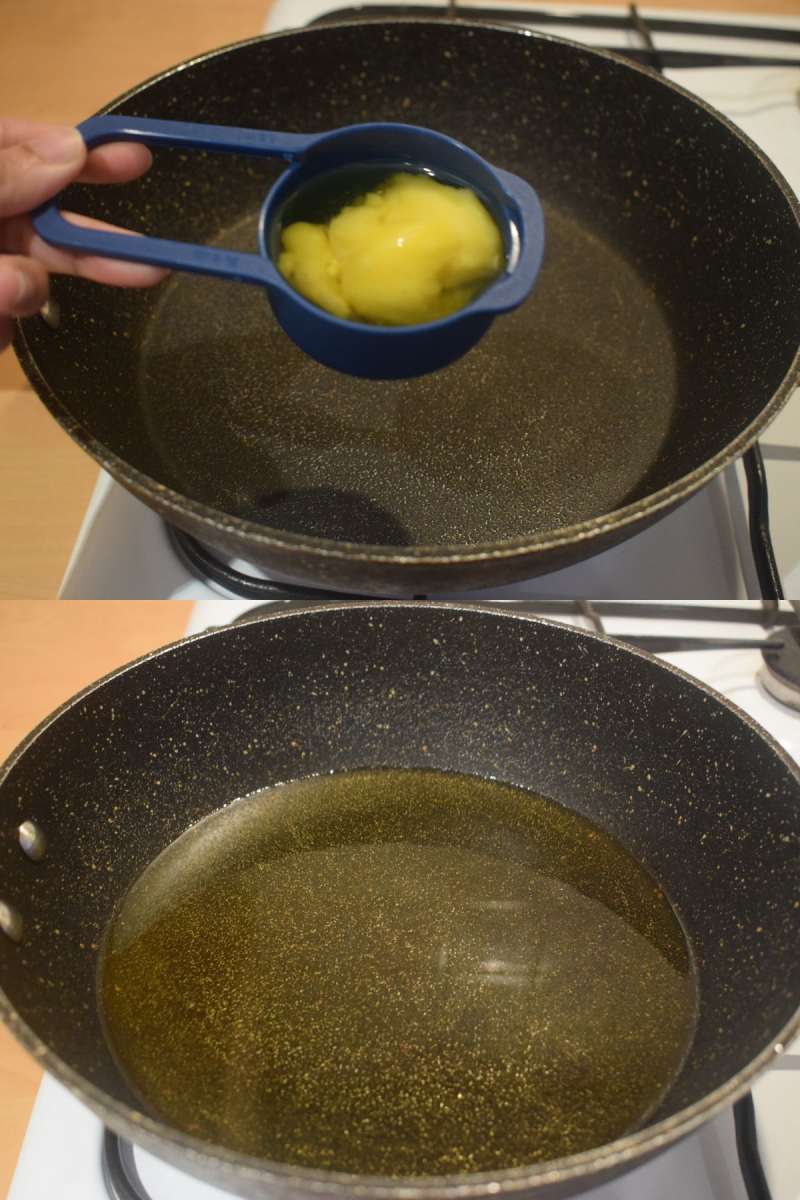
- Add ½ cup sooji, 2 tablespoons cashew nuts, 1 tablespoon almonds into the pan and give a nice stir.
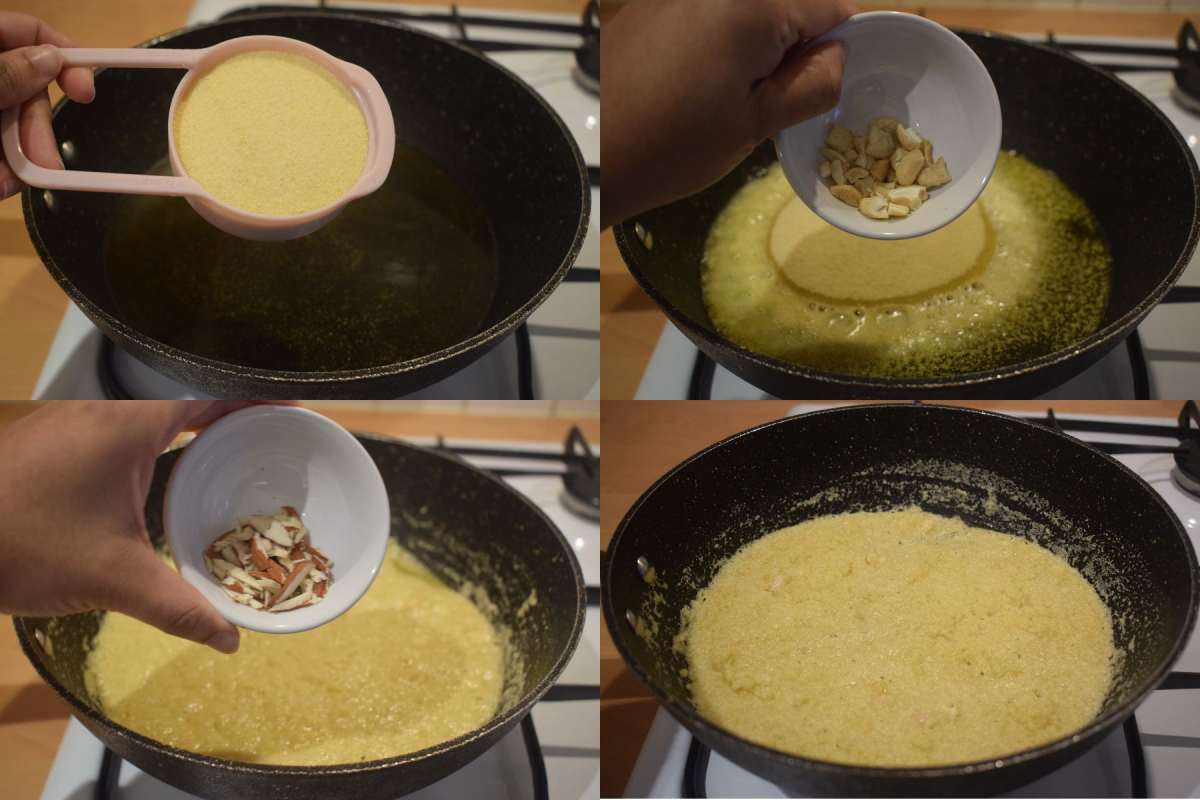
- Cook it on low flame for 8-9 minutes until the ghee gets separated. Stir it continuously for even roasting. Be patient and consistent at this stage, or else semolina will not get cooked properly.
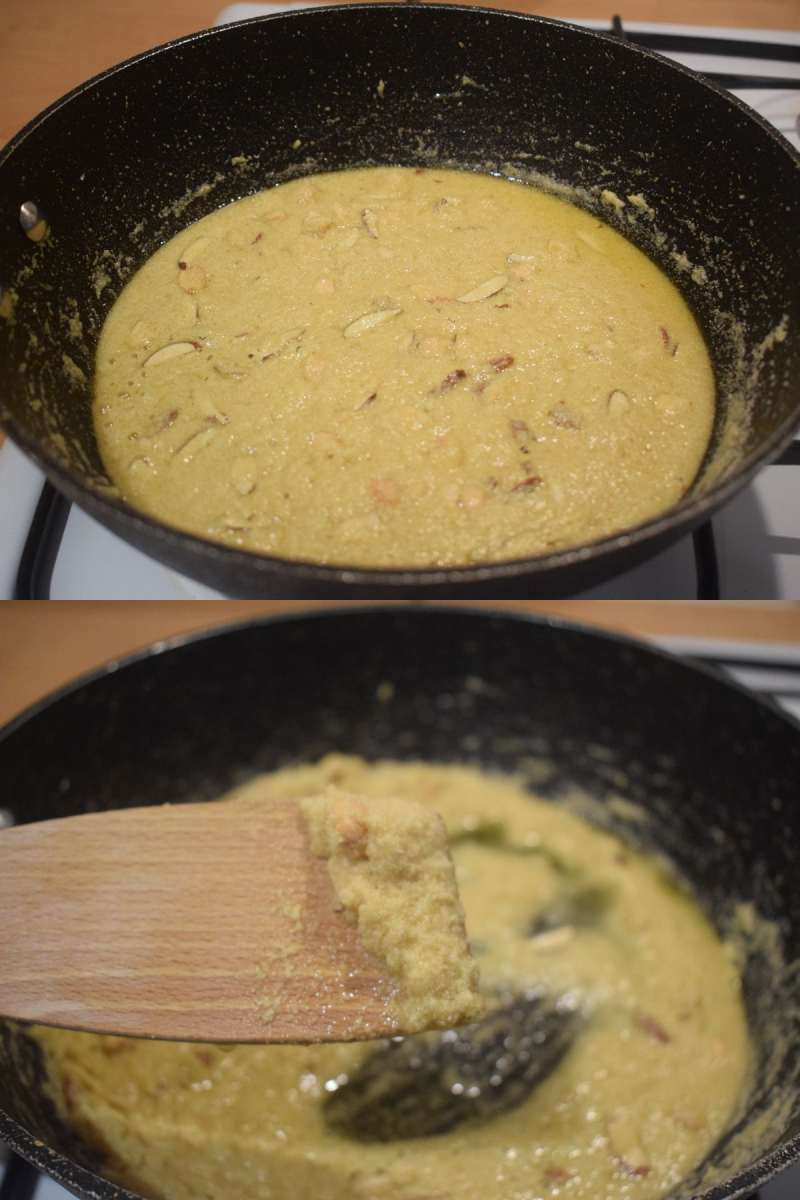
- Add 1 tablespoon raisin, ¾ teaspoon cardamom powder at this stage and give a nice stir.
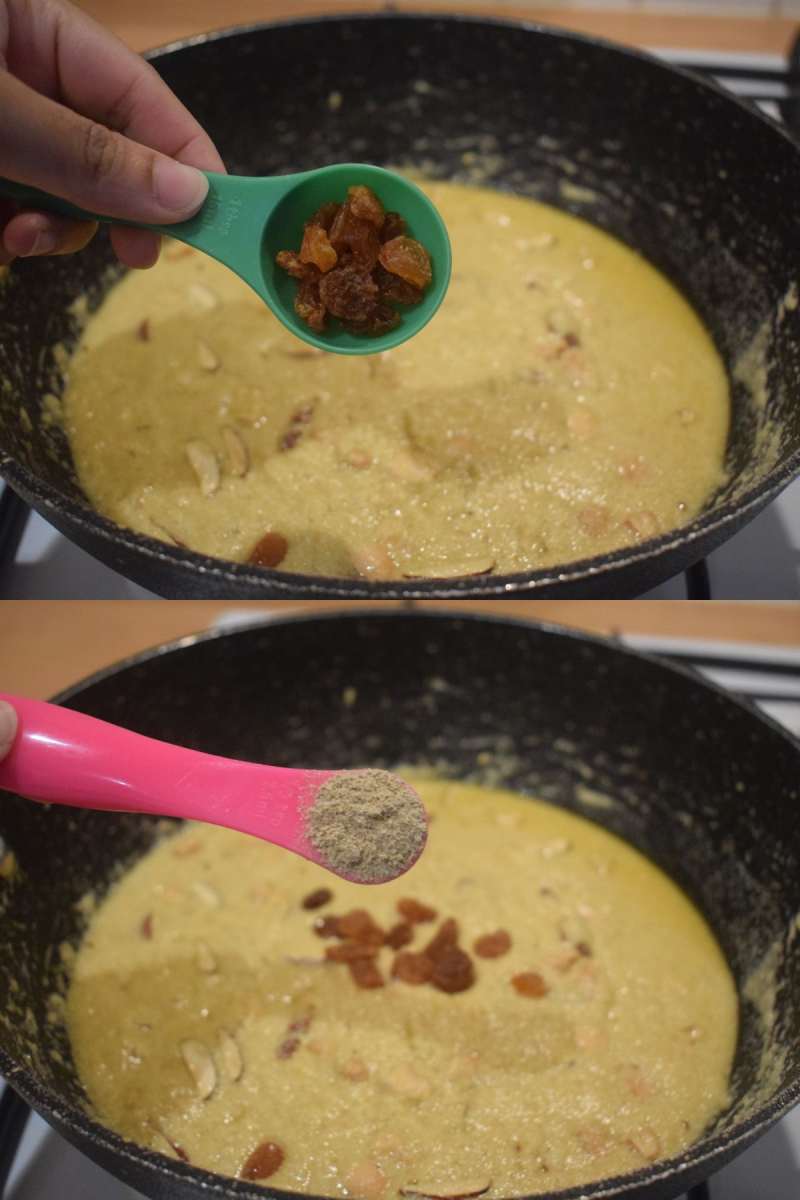
- Immediately pour the hot sugar syrup (Step 2) slowly into the pan and stir it continuously to avoid any lumps.
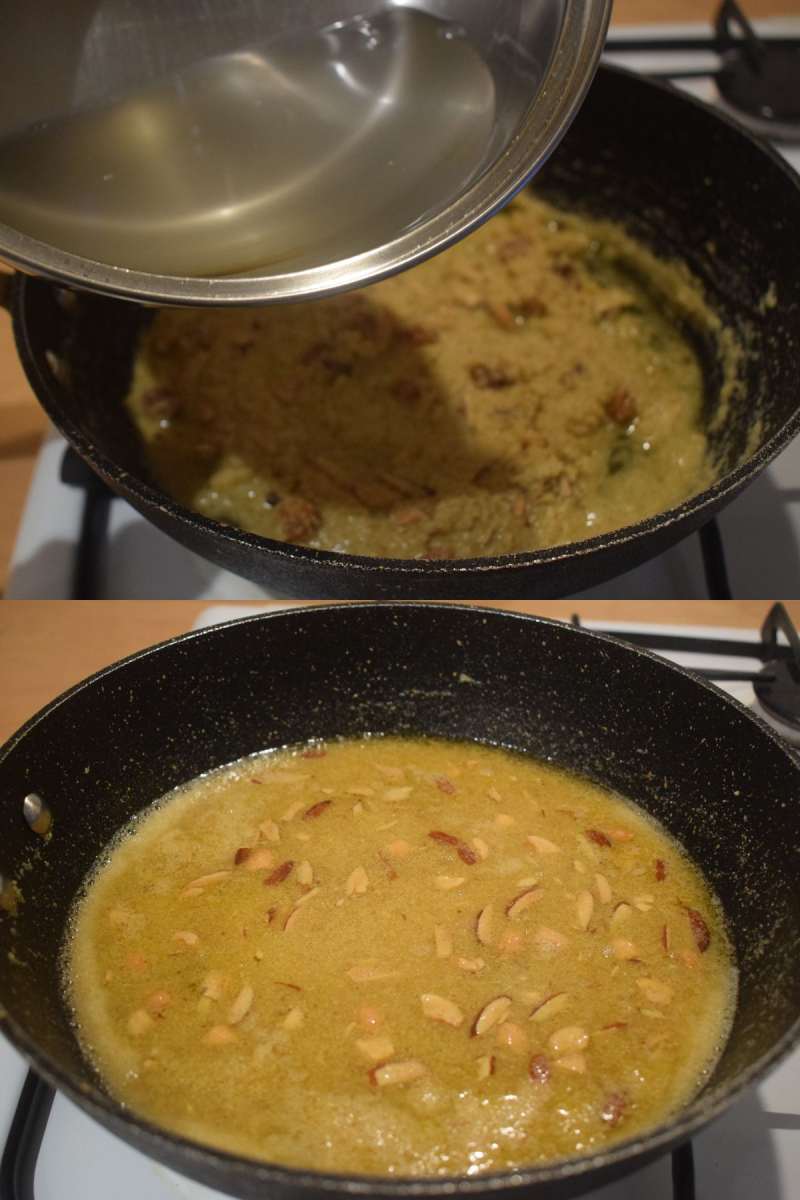
- Now cook it on low flame. The semolina will start absorbing water and the mixture will turn thick. Stir the content frequently. At this stage, halwa will be soft and moist like pudding.
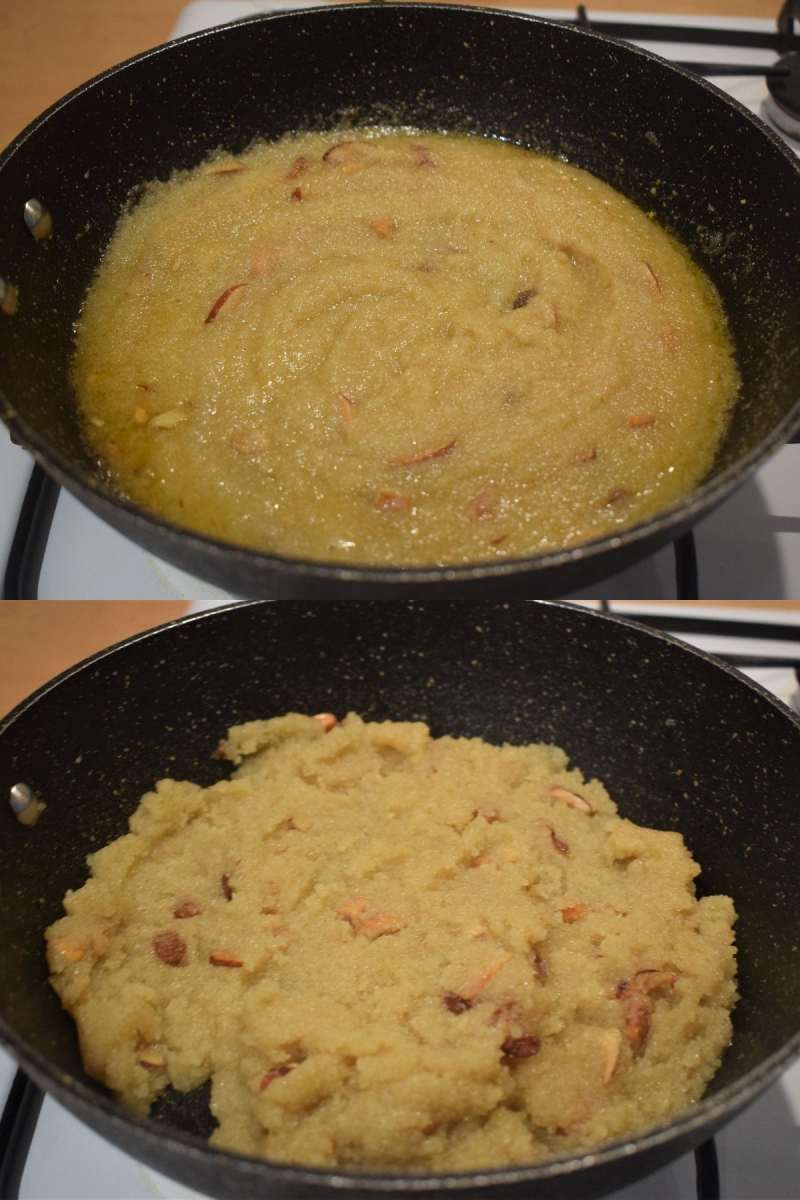
- Once the semolina will absorb all the water then the sides will get separated and ghee will be visible. At this stage, switch off the flame and put the pan down. Now your suji ka halwa is ready to serve.

Serving Instruction
Serve the sooji ka halwa on a serving plate or in a serving bowl. Serve warm to enjoy its best taste. Serve the suji halwa recipe as dessert after a meal or as evening snacks and enjoy the Indian delicacy.
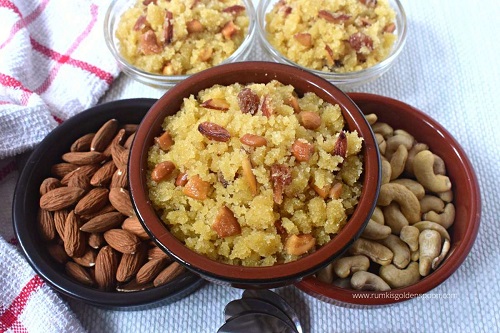
Ingredients
1 cup = 250 ml
- ½ cup Sooji (Semolina)
- ⅓ cup Ghee (clarified Butter)
- ½ cup Sugar
- 1¼ cups Water
- 2 tablespoons Cashew nuts (Kaju), chopped
- 1 tablespoon Almonds (Badam), chopped
- 1 tablespoon Raisins (Kishmish)
- ¾ teaspoon Cardamom powder (Elaichi powder)
Instructions
- First, take a pan and add 1¼ cups of water to it.
- Add ½ cup sugar and give a nice stir. Put the flame on medium-high and cook until the sugar gets dissolved and sugar syrup starts boiling. Stir it in between to dissolve the sugar. Then switch off the flame and keep the pan aside.
- Put a pan on flame and allow it to dry.
- Add ⅓ cup clarified butter aka ghee into a pan and allow it to melt completely.
- Add ½ cup sooji, 2 tablespoons cashew nuts, 1 tablespoon almonds into the pan and give a nice stir.
- Cook it on low flame for 8-9 minutes until the ghee gets separated. Stir it continuously for even roasting. Be patient and consistent at this stage, or else semolina will not get cooked properly.
- Add 1 tablespoon raisin, ¾ teaspoon cardamom powder at this stage and give a nice stir.
- Immediately pour the hot sugar syrup (Step 2) slowly into the pan and stir it continuously to avoid any lumps.
- Now cook it on low flame. The semolina will start absorbing water and the mixture will turn thick. Stir the content frequently. At this stage, halwa will be soft and moist like pudding.
- Once the semolina will absorb all the water then the sides will get separated and ghee will be visible. At this stage, switch off the flame and put the pan down. Now your suji ka halwa is ready to serve.

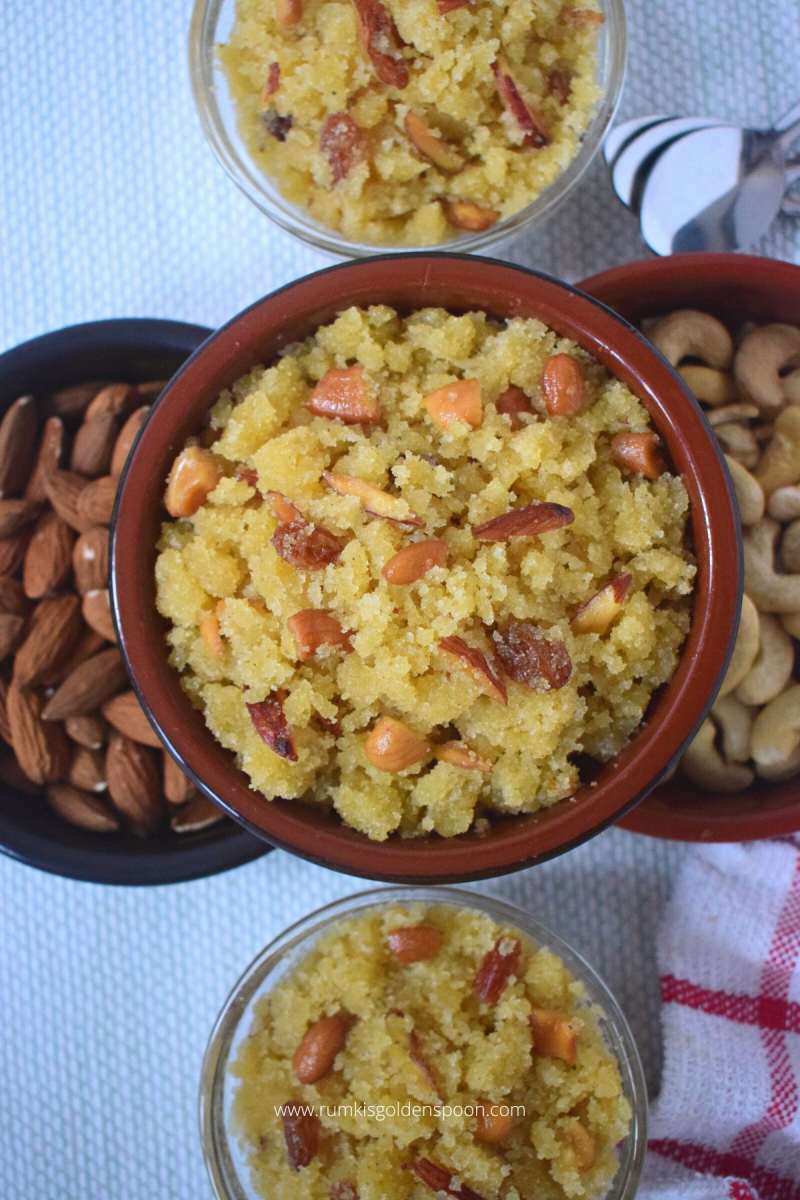
3 comments
[…] because of the lengthy process but it is prepared during festive seasons at least once a year. Suji ka halwa, Aate ka halwa, Gajar ka halwa are more often halwa recipes prepared in Indian […]
Your recipes sound really yummy. It would be good if you had a “Jump to Recipe” on your pages so I could print them out instead of reading off a pad.
Thanks
Janine
Hi Janine,
Thank you for your feedback. I already have the “Jump to recipe” and “Print recipe” buttons on the top of each recipe page. Please feel free to use them.